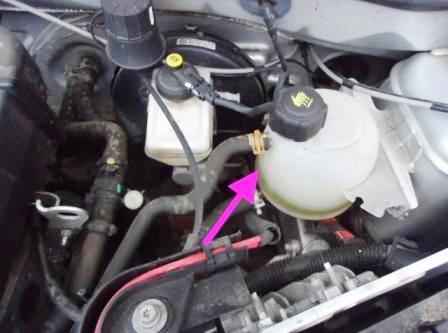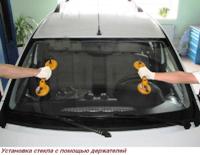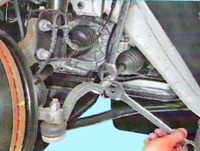It is advisable to check the liquid level in the expansion tank of the cooling system at each inspection of the car before leaving, and always in case of overheating of the engine and the associated release of liquid from the system
To check the fluid level, install the car on a horizontal platform.
The fluid level should be checked on a cold engine.

Max and Min marks are marked on the side wall of the expansion tank, between which the fluid level should be on a cold engine.
When the engine is warmed up to operating temperature, the coolant level in the reservoir may be slightly above the Max mark.
If it is necessary to add liquid to the system on the road, on a hot engine, then stop it.
After waiting at least ten minutes, cover the cap of the expansion tank with a rag and unscrew it a quarter of a turn, releasing excess pressure in the cooling system.
If the fluid level is at or below the mark, unscrew the cap of the expansion tank and add coolant to the tank, slightly not bringing the level to the Max mark.
Remove coolant leaks with a rag. We wrap the cap of the expansion tank.
Replacing engine coolant
In accordance with the maintenance schedule, we replace the coolant every 90 thousand kilometers or after 3 years, whichever comes first.
We perform work on a cold engine, placing the car on a viewing ditch or overpass.
If the engine is hot, let it cool down and then relieve excess pressure in the cooling system.

Remove the protection of the power unit, Figure 2.
There are no drain plugs in the radiator and cylinder block.
We substitute a wide container with a volume of at least 6 liters under the radiator.
To reduce the intensity of draining the liquid at the initial moment, the cap of the expansion tank should be tightly wrapped.

From the bottom of the car, use sliding pliers to compress the ends of the clamp and slide the clamp along the hose, Figure 3.

Disconnect the hose from the radiator pipe, Figure 4, and drain the liquid into a substituted container.
To increase the intensity of draining the fluid, unscrew the cap of the expansion tank and the cap of the fitting (bleeding air from the cooling system) located on the fluid supply hose to the heater.
Flush the cooling system with water through the expansion tank.
Pour water through the cooling system until the water flowing from the radiator outlet hose is clear.
After we put the outlet hose on the radiator pipe and fasten it with a clamp.
Pour liquid into the engine cooling system through the expansion tank until the liquid begins to flow out through the air outlet.
We wrap the cap of the air outlet and the cap of the expansion tank.
We start the engine. When the engine warms up, the outlet (lower) radiator hose should be cold for some time, and then quickly warm up, which will indicate the beginning of fluid circulation in a large circle.
After waiting for the cooling fan to turn on, we stop the engine.
After the engine has cooled down, check the coolant level. If necessary, we bring it to the norm.











